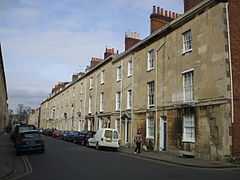St John Street, Oxford

St John Street is a street in central Oxford, England.[1][2] The street mainly consists of Georgian-style stone-faced Grade II listed terraced houses. It was built as a speculative development by St John's College starting in the 1820s and finishing in the 1840s at the start of the Victorian era.
At the northern end is Rewley House (housing Oxford University's Department of Continuing Education, formally Kellogg College) and near the southern end is the Sackler Library, which opened in 2001. To the south is Beaumont Street and to the north is Wellington Square. St John Street runs parallel with St Giles' (linked via Pusey Street) to the east and Walton Street to the west.
Note that part of Merton Street was once known as St John Street.[1]
Famous residents
The Oxfordshire-born painter William Turner (1789–1862) lived at No. 16 from 1833 until his death. The house is marked with a blue plaque.[3][4]
Other famous residents of St John Street have included the theologians Henry Chadwick and Arthur Peacocke; authors P. D. James, Iain Pears and J. R. R. Tolkien; and musician Thom Yorke. The curator of the Museum of the History of Science (in Broad Street, not far away), Kurt Josten, lived in rooms in St John Street.[5]
References
- ↑ 1.0 1.1 Hibbert, Christopher, ed. (1988). "St John Street". The Encyclopaedia of Oxford. Macmillan. p. 402. ISBN 0-333-39917-X.
- ↑ "Virtual Tour of Oxford". Department of Chemistry, University of Oxford. Retrieved 10 December 2012.
- ↑ Warr, Elizabeth Jean (2011). The Oxford Plaque Guide. Stroud, Gloucestershire: The History Press. pp. 127–128. ISBN 978-0-7524-5687-4.
- ↑ "William Turner `of Oxford'(1789–1862), Artist, 16 St John Street, Oxford". Oxfordshire Blue Plaques Board. Retrieved 10 December 2012.
- ↑ Lowe, Ian (12 July 1994). "Obituary: Kurt Josten". The Independent. Retrieved 10 December 2012.
External links
- Summer Rain in St John Street, Oxford Daily Photo, 26 July 2007
Coordinates: 51°45′21″N 1°15′42″W / 51.75583°N 1.26167°W